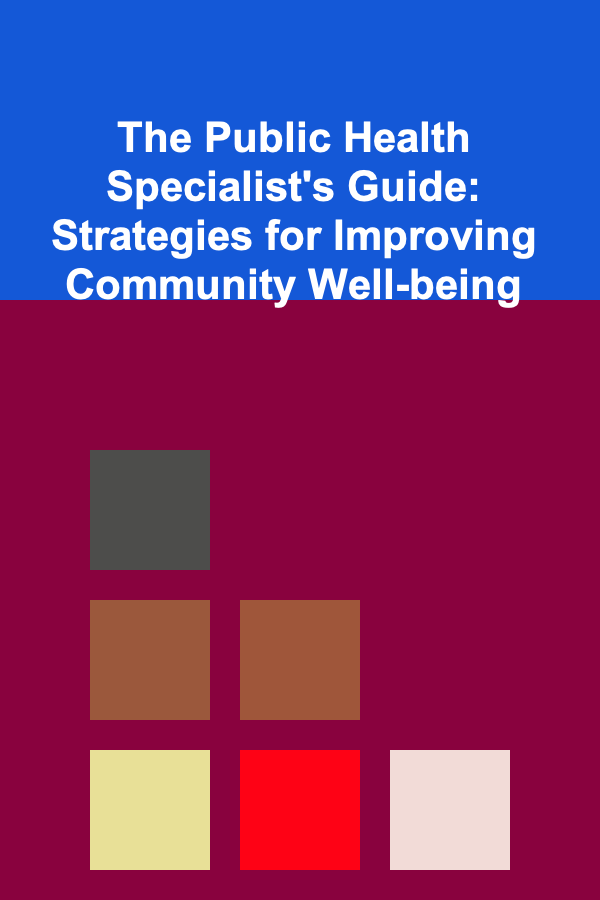
10 Tips for Small Urban Gardens: A Landscaping To-Do List
ebook include PDF & Audio bundle (Micro Guide)
$12.99$9.99
Limited Time Offer! Order within the next:
Not available at this time

In an era where urban spaces are rapidly expanding, and nature is often pushed aside, small urban gardens offer a refreshing escape. Whether you live in an apartment with a balcony or a small townhouse with a backyard, transforming limited outdoor spaces into lush, green retreats can improve your quality of life, offer stress relief, and even provide fresh produce. However, designing and maintaining a garden in an urban environment requires thoughtful planning, resourcefulness, and creativity.
In this comprehensive guide, we'll explore 10 tips to help you make the most out of your small urban garden. From choosing the right plants to optimizing space and creating functional outdoor rooms, this landscaping to-do list will help you craft an oasis right in the heart of the city.
Maximize Vertical Space
One of the greatest challenges when creating a garden in a small urban space is the lack of square footage. Fortunately, you can utilize vertical space to grow more plants and create visual interest without sacrificing room. By focusing on height, you can bring greenery to walls, fences, and even the sides of buildings.
Ways to Maximize Vertical Space:
- Vertical Planters: Install vertical planters or shelving units along your walls or fences. These can hold a variety of plants, from herbs and flowers to small vegetables and succulents.
- Climbing Plants and Vines: Use climbing plants such as ivy, jasmine, or morning glories that will grow upwards, covering trellises or garden walls.
- Hanging Baskets: These are perfect for trailing plants, flowers, or even small vegetables like strawberries. Hang them from the ceiling or hooks attached to fences or overhangs.
- Wall-mounted Pot Holders: These holders or racks can be used to keep your pots elevated, making it easier to care for your plants and saving valuable floor space.
Using vertical space effectively can give your garden an abundant and multi-layered look, providing areas for both decorative and functional planting.
Opt for Multi-Use Furniture
In small spaces, furniture serves more than just a functional purpose -- it must also contribute to the garden's overall aesthetics and versatility. Opt for garden furniture that can serve more than one function, allowing you to create an inviting outdoor space while preserving valuable space for plants.
Ideas for Multi-Use Furniture:
- Storage Benches: A bench that doubles as a storage unit can help you hide away gardening tools, cushions, or pots. This maximizes seating while reducing clutter.
- Convertible Tables: A folding or adjustable-height table can be used for meals or potting plants, depending on the time of day and your needs.
- Ottomans with Hidden Storage: Ottoman-style seating that opens up to reveal hidden compartments is perfect for small gardens that need to store tools, extra soil, or other garden essentials.
- Built-in Seating with Planters: Design your outdoor seating to incorporate built-in planters on the sides or beneath the structure. This allows you to combine functionality with greenery.
By choosing versatile, space-efficient furniture, you can create a garden that feels spacious and welcoming, no matter how small it is.
Use Raised Beds for Better Soil Control
In urban environments, soil quality can often be poor, contaminated, or compacted, making it difficult for plants to thrive. Raised garden beds are a great solution because they allow you to control the soil composition, drainage, and plant spacing. These beds are also easier to access and maintain, particularly if you have limited mobility.
Benefits of Raised Beds:
- Improved Drainage: Raised beds allow excess water to drain away from your plants, which is essential in small urban spaces where soil compaction is often a problem.
- Soil Control: You can fill raised beds with high-quality soil tailored to the needs of your plants. This is particularly important in cities where the native soil may be poor or contaminated.
- Space Efficiency: Raised beds can be arranged close together or stacked to create multiple levels, utilizing vertical space to increase your growing area.
- Less Weeding: With raised beds, the soil is less prone to weed invasion, making your gardening experience more manageable and enjoyable.
You can build raised beds using materials like wood, bricks, or even repurposed pallets. These beds can be as small or as large as your space allows, giving you the freedom to experiment with plant variety and layout.
Create a Vertical Herb Garden
Herbs are a perfect choice for small urban gardens because they thrive in containers and can be grown in almost any space, from windowsills to balconies. Plus, they are functional and can be used in cooking, making them even more valuable in a small garden.
Tips for Growing Herbs Vertically:
- Use Hanging Baskets: Hang baskets along your balcony or fence to grow herbs like basil, mint, rosemary, and thyme. These plants do well in pots and won't require a lot of space.
- Wall-mounted Planters: Install a wall-mounted herb garden with small pots or containers. This could be on your kitchen balcony or the side of a wall facing the sun.
- Repurposed Containers: Use old cups, mugs, or jars to grow individual herb plants. These can be arranged vertically along a window or hung from a fence.
- Herb Towers: Consider investing in a tiered herb garden tower, which allows you to grow multiple types of herbs in a single structure.
Herbs don't just provide fresh flavors for your meals; they can also add texture and fragrance to your garden, making them a valuable addition.
Utilize Containers for Flexibility
Container gardening is an excellent way to maximize the available space in a small urban garden. Containers are highly versatile, allowing you to plant almost anything -- from flowers and herbs to vegetables and small fruit trees.
Advantages of Container Gardening:
- Mobility: One of the biggest benefits of container gardening is the ability to move plants around. You can adjust their position based on the amount of sunlight or shade they receive, or rearrange them when you want to change the garden's layout.
- Drought Resistance: Containers dry out more quickly than in-ground gardens, so they require careful watering. However, you can choose containers that are designed to hold moisture better, reducing the frequency of watering.
- Customizable Size and Shape: Whether you're working with a balcony or a small backyard, containers come in all shapes and sizes, allowing you to create the perfect planting space for your garden.
- Minimal Soil Requirements: Containers often don't require as much soil, and you can ensure the soil is appropriate for the plant you're growing, avoiding issues like poor drainage or compacted soil.
You can use everything from traditional clay pots to modern plastic containers, hanging baskets, or even repurposed items like old buckets or barrels to create your container garden.
Incorporate Edible Plants for a Sustainable Garden
Edible plants are a great addition to any urban garden because they contribute to sustainability while providing fresh, homegrown produce. Urban gardens are often limited by space, but that doesn't mean you can't grow food. Whether you want to grow fruits, vegetables, or herbs, there's always room for edible plants.
Tips for Growing Edible Plants:
- Choose Compact Varieties: Look for dwarf or compact varieties of vegetables and fruits that are bred to thrive in containers or smaller spaces. These plants take up less room while still providing a satisfying harvest.
- Consider Vertical Gardens for Food: As mentioned earlier, vertical gardening isn't just for ornamental plants. You can grow peas, tomatoes, cucumbers, and even strawberries vertically with the right setup.
- Plan for Companion Planting: Some plants thrive when grown next to certain other plants. For example, growing basil with tomatoes can enhance both plant's growth and flavor. Plan your edible garden with companion planting techniques for the best results.
- Growing Indoor Food: If you don't have access to an outdoor space, consider growing food indoors in windowsill containers. Herbs, lettuces, and small greens grow well indoors with sufficient light.
Edible plants don't just make your garden more beautiful -- they also contribute to a sustainable and self-sufficient lifestyle, offering a regular supply of fresh produce for your meals.
Use Smart Irrigation Systems
Watering is one of the most crucial aspects of maintaining a garden, especially in small urban spaces where plants may not have access to natural rainfall or large water reservoirs. A smart irrigation system can help automate watering, saving you time and water while ensuring your plants get the right amount of hydration.
Benefits of Smart Irrigation Systems:
- Time-Saving: Automated irrigation systems ensure your plants are watered on a regular schedule, without you having to remember or spend time manually watering them.
- Water Efficiency: Smart irrigation systems can monitor soil moisture levels and adjust watering accordingly, preventing overwatering and reducing water waste.
- Convenience: With a smart system, you can control watering times from your phone, ensuring your plants get consistent care even when you're not around.
Investing in a simple drip irrigation system or a smart irrigation controller can make your gardening experience much easier, especially if you're busy and don't have the time to water manually every day.
Choose Low-Maintenance Plants
In a small urban garden, you'll want plants that require minimal care while still providing beauty and greenery. Low-maintenance plants are ideal for busy individuals who may not have the time to tend to their garden every day.
Recommended Low-Maintenance Plants:
- Succulents: These drought-resistant plants require very little water and can thrive in containers or on windowsills. They also come in a variety of shapes and colors, making them aesthetically appealing.
- Herbs: Most herbs are easy to care for and can thrive in small spaces, especially if grown in containers. Rosemary, thyme, mint, and basil are hardy options.
- Ornamental Grasses: These plants provide texture and movement in your garden with minimal effort. They are well-suited to small urban spaces and require little maintenance.
- Perennials: While annuals require replanting every year, perennials come back year after year. Plants like lavender, daylilies, and hostas provide long-term beauty with minimal upkeep.
By choosing low-maintenance plants, you can enjoy a beautiful garden without the need for constant attention.
Incorporate Privacy Features
In urban settings, privacy can be a concern, especially if you live in close proximity to neighbors or on a busy street. Adding privacy features to your small garden can make it feel more secluded and peaceful, providing a relaxing escape from the hustle and bustle of city life.
Privacy Ideas:
- Fencing and Trellises: Installing a fence or trellis can block the view of neighboring buildings or streets. Add climbing plants like ivy or roses to soften the structure and create a more natural barrier.
- Plant Privacy Screens: Tall plants such as bamboo, ornamental grasses, or evergreens can create natural privacy screens, effectively shielding your garden from prying eyes.
- Outdoor Curtains: For a more flexible option, you can hang outdoor curtains from a pergola, gazebo, or balcony railing to provide privacy when needed.
By incorporating privacy features, you can enjoy your small urban garden without feeling exposed to the outside world.
Design for Comfort and Functionality
Finally, a well-designed garden isn't just about the plants; it's also about creating an environment where you can relax and enjoy your outdoor space. Design your garden with both comfort and functionality in mind.
Tips for Creating a Comfortable Garden:
- Seating Areas: Include cozy seating areas where you can relax, whether it's a comfortable chair, a hammock, or a built-in bench.
- Pathways: Create small paths or stepping stones to lead visitors through your garden. This not only adds to the visual appeal but also makes it easier to navigate.
- Lighting: Add outdoor lighting to create ambiance in the evenings. Solar-powered lights are energy-efficient and can be placed along pathways, in planters, or around seating areas.
- Water Features: Consider adding a small fountain or birdbath for a calming effect. The sound of running water can create a peaceful atmosphere in an urban environment.
By designing your garden with comfort and functionality in mind, you can transform your small urban space into a true sanctuary, perfect for relaxation and enjoyment.
A small urban garden is more than just a space for plants -- it's an opportunity to create a functional, beautiful, and sustainable outdoor living area that enhances your life. By implementing these 10 tips, you can turn even the tiniest of urban spaces into an oasis that reflects your personal style and love for nature. Happy gardening!

How to Attract Clients for Your Financial Planning Services
Read More
How to Build a Portfolio to Attract Translation Clients
Read More
How to Engage Kids with Fun Learning Games at Home
Read More
How to Package Your Homemade Soap Professionally on a Budget
Read More
How to Use Wall Space for Craft Supply Display
Read More
The Public Health Specialist's Guide: Strategies for Improving Community Well-being
Read MoreOther Products

How to Attract Clients for Your Financial Planning Services
Read More
How to Build a Portfolio to Attract Translation Clients
Read More
How to Engage Kids with Fun Learning Games at Home
Read More
How to Package Your Homemade Soap Professionally on a Budget
Read More
How to Use Wall Space for Craft Supply Display
Read More